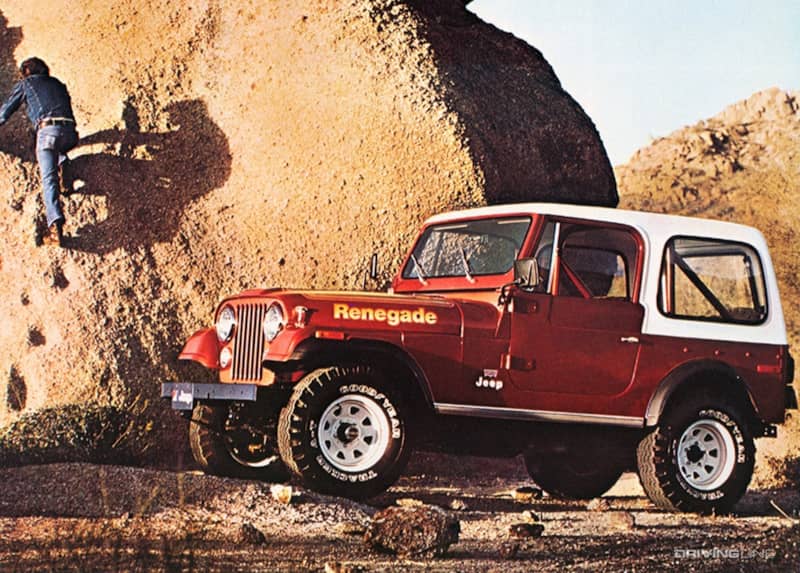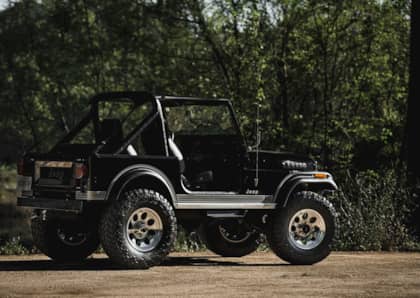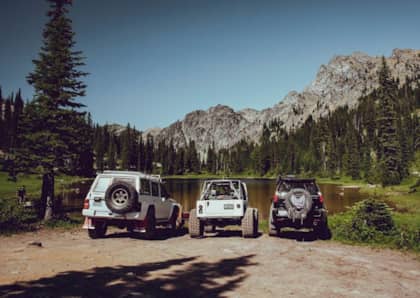The 1976-1986 Jeep CJ-7 Modernized The Original Willys Kaiser 4x4 SUV And Led Us To The Wrangler
The Jeep CJ holds a special place in 4x4 history, as it was this model that helped establish the brand as the go-to for rugged, off-road capability. The 'Civilian Jeep' was more than a little rough around the edges when it was first introduced following World War II, however, and it wasn't until American Motors Corporation bought Jeep from parent company Kaiser that the most compelling version of the CJ formula hit the trails.

The Jeep CJ-7 arrived in the mid-1970s, and it represented the final evolution of the original 'go-anywhere' formula that had defined the model up to that point. Despite AMC's limited development budget, the CJ-7 featured a number of innovations that helped build a strong foundation for the next stage of Jeep's growth—the Wrangler that followed—and provided the most modern interpretation of what a no-compromise sport-utility vehicle had to offer.
Mil-Spec Is No Longer Enough
The automotive world had changed considerably in the roughly 20 year period between the CJ-5 and the CJ-7 debuts. The expansion of the interstate highway system dramatically changed how Americans moved around the country, pushing speeds up to a level where the civilian version of what had originally been a military design felt distinctly out of its element. At the same time, expectations from truck owners about daily driver comfort had also risen significantly, pushed in part by GM and Ford's late-1960s redesigns of their pickups past the point of mere utilitarian trucks, and further propelled by Jeep's own Wagoneer series of family-oriented SUVs.

It was clear that the CJ had to move with the times. While the 5 stayed in the line-up, to better compete with the new sport-utility and truck standard a more compliant yet still capable model needed to be added to showrooms.

The first order of business for AMC was to address two primary concerns about the Jeep's chassis. The ultra-short wheelbase of the CJ-5 made it nimble on tight trails, but had also been a target for critics concerned by how easy it was to upset the vehicle's equilibrium with abrupt steering inputs.

Jeep had already added 3 inches to the CJ-5's wheelbase earlier in the decade, but for the 1976 CJ-7 another 10 inches entered the equation, moving from 83.5 inches to 93.5 inches and providing a meaningful boost in straight-line stability. It wasn't just a stretched CJ-5 platform, either: the frame went from open channel to C-section rails, widening at the rear to accommodate a new axle and suspension location points. These further increased the new Jeep's planted feel and marked a distinct generational change for the CJ.

That longer chassis also improved how smooth the CJ-7 rode, making it less bouncy than the CJ-5. Revised floor pans made for increased passenger room, and full-size doors also made it easier to get in and out of the vehicle. A removable plastic hardtop appeared on the options sheet for the first time, and so did air conditioning and an automatic transmission (with the latter made possible by the extra room available underneath the Jeep).
Still Tough
Jeep made sure not to subtract anything from the CJ when it came to off-road prowess. Two four-wheel drive systems, including a full-time unit, were offered with the CJ-7, and engine options consisted of a small four-cylinder and a pair of straight sixes that delivered decent torque, especially the later 258 cubic inch design. A V8 engine was offered for the first time with the CJ, too, and the 304 cubic inch motor put in an appearance until 1981, delivering 125 hp and just under 220 lb-ft of torque.

Even with the automatic in the cards, most versions of the CJ-7 came with a manual gearbox, ranging from three to five forward speeds. A Dana 30 front axle was common up front, with an AMC 20 rear axle (eventually replaced by a Dana 44 during the final model year).
Hawks and Eagles
As with current Jeep marketing, AMC did its best to keep the CJ-7 feeling fresh over its 10 years of production. As the company struggled financially, this was primarily accomplished via a number of 'special editions,' including the Jamboree Commemorative Edition, the somewhat luxurious Laredo, the Golden Hawk / Golden Eagle, and the Renegade. Some of these models and trims were also offered on the smaller CJ-5, which continued to find customers.

Essentially shuffled-deck combinations of options, decals, and tire sizes, Jeep's constantly shifting trim list proved popular, and models like the Golden Eagle even got significant screen time on the Dukes of Hazard TV show in 1980

Jeep also produced an even longer wheelbase version of the CJ-7 called the CJ-8. Also known as the 'Jeep pickup' and the 'Scrambler,' the CJ-8 featured an open cargo bed that made full use of the extra 10 inches in length provided by the stretched platform. Offered for a five year period starting in 1981, the Scrambler was smaller than the J Series/Gladiator full-size trucks and in some ways was a precursor to the later Comanche compact pickup.
Laying The Foundation For Wrangler
Despite AMC's failing partnership with Renault, Jeep continued to develop new products in the 1980s, including the ground-breaking Cherokee SUV and a replacement for the CJ-7, the Wrangler YJ. The latter appeared in 1986 just prior to Jeep's sale to Chrysler, and together the two vehicles lead to a renaissance for the brand that helped build it into the global force it is today.

It's safe to say that without the CJ-7, there would have been no Wrangler. Improving on the CJ-5's comfort while preserving its capabilities proved that there was a substantial market out there for a true off-road vehicle that could also tag in for daily driving without asking owners to endure a jittery ride, poor protection from the elements, or a cramped cabin. More than just a larger CJ-5, the CJ-7 represented a step forward in redefining the civilian Jeep in an increasingly competitive world.

By standing on the shoulders of the CJ-7 the Wrangler's designers were able to maintain its iconic looks and top-tier trail cred, while thoroughly reworking its platform and driveline to produce the vehicle that would lead Jeep into the future.











